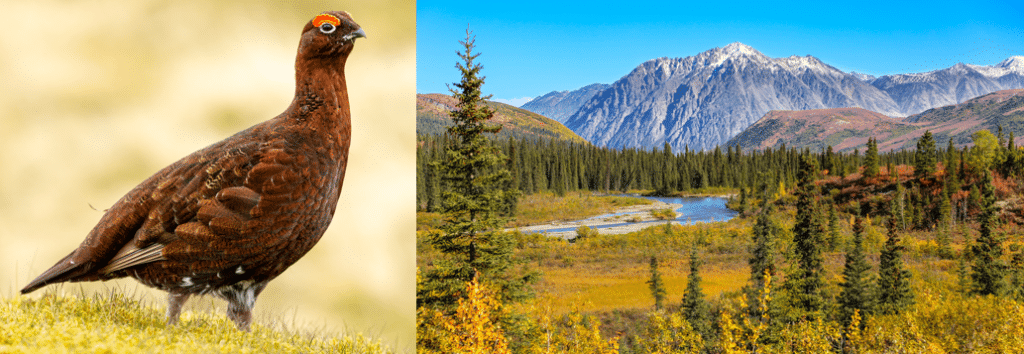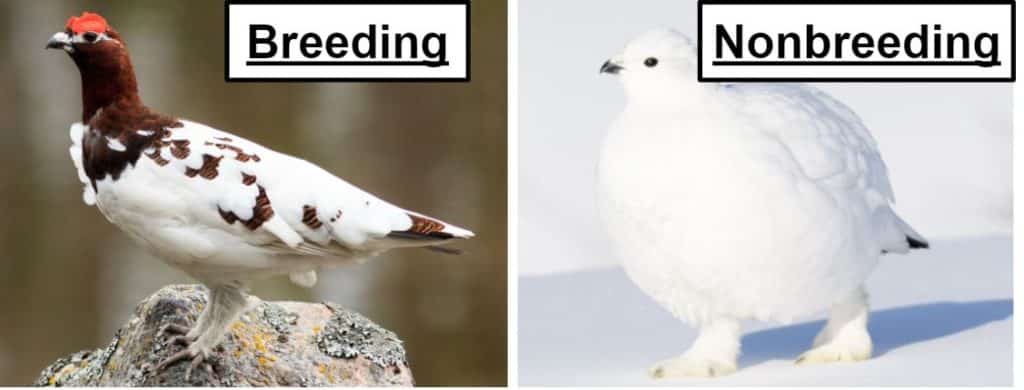10 MOST Common Birds in Denali National Park (2025)
What kinds of birds can you find in Denali National Park?

This question is hard to answer because of the vast number of birds found in the park. Did you know there have been over 150 species recorded here? As you can imagine, there was no way to include this many birds in the below article. So instead, I tried to focus on the birds that are most regularly seen and observed.
Below I have listed the TEN birds you are most likely to find while visiting Denali National Park.
#1. Willow Ptarmigan
- Lagopus lagopus

Identifying Characteristics:
- Breeding males have a chestnut and brown neck and back, a white belly, and a red eyebrow.
- Breeding females are a mixture of brown, black, and white.
- In winter, both sexes turn completely white!
Willow Ptarmigan are masters of camouflage in Denali National Park! This is especially true during winter when these birds are completely white and match the snow perfectly.
Interestingly, Willow Ptarmigans often create underground burrows in the snow to avoid the bitter cold. You could be looking for them in the mountains and not realize they are nestled safely underneath you. 🙂 In addition, they also have feathered feet to keep them warm.
Lastly, I am happy to tell you that male Willow Ptarmigans are great fathers. They are the only grouse species that help raise their young, choosing to stay with their mate from the beginning of the breeding season until the chicks are independent.
#2. Canada Jay / Gray Jay
- Perisoreus canadensis

Identifying Characteristics:
- Paler grey on the belly. Darker gray on the backs.
- White cheeks, throat, and forehead.
- Short beak and a long tail.
It’s hard to describe a Canada Jay other than “cute.” These grey birds are smart and adapt easily to their surroundings in Denali National Park, which allows them to consume almost anything.
Seriously, they have been observed eating the following weird things: ticks off the back of a moose, baby bats, amphibians, and baby birds, in addition to more normal foods like invertebrates, seeds, and berries.
Canada Jay Range Map
Another fascinating fact about them is that they raise their babies during late winter! Interestingly, they don’t attempt to raise a second brood of babies in May or June, which is when most other bird species have babies, and conditions seem more favorable.
So do you call this bird a Canada Jay or a Gray Jay?
Well, the correct name is now Canada Jay, as the name was changed in 2018 by the American Ornithological Society from the Gray Jay. But old habits die hard, and many birders in the United States still refer to this bold corvid as a Gray Jay.
#3. Short-billed Gull
- Larus brachyrhynchus
Identifying Characteristics:
- Adults measure between 16.1 and 18.1 inches in length and have a 42.1 to 44.9-inch wingspan.
- Breeding adults are medium gray above and white below.
- They have a white head, black wingtips with white spots, yellow legs, dark eyes, and a yellow bill.
Short-billed Gulls occupy various habitats and spend time along the shorelines of lakes and rivers in Denali National Park. They nest in habitats associated with the far north, including taiga, tundra, marshes, meadows, coastal cliffs, and islands on rivers and lakes.

Like most gulls in Alaska, these birds are opportunistic omnivores and have several foraging strategies. They can catch prey in the air, skim along the water’s surface, or plunge in after prey. They’re sometimes observed attacking other seabirds and stealing their prey.
Short-billed Gulls used to be classified as a sub-species of the common gull. They weren’t recognized as a separate species until 2021! Partners in Flight rate them as a species of low conservation concern. However, oil spills greatly affect local populations, which damage their plumage and habitats and kill their prey.
#4. Black-billed Magpie
- Pica hudsonia

Identifying Characteristics:
- A large black and white bird with a long tail.
- In the right light, you can see beautiful blue iridescent feathers on the wings and tail.
It’s hard to miss these bold birds in Denali National Park!
Black-billed Magpies demand your attention. They are very social, noisy, and comfortable living amongst people and are commonly seen in smaller towns. Naturally, they live in open grasslands and plains and tend to avoid dense forests.
Black-billed Magpie Range Map

Being part of the Corvid family, Black-billed Magpies are incredibly intelligent. One interesting behavior is that they seem to have funerals when they discover a deceased magpie. Individual birds will begin calling loudly to attract more magpies, eventually having as many as 40 birds gathered for 10-15 minutes before flying away silently.
#5. Spruce Grouse
- Canachites canadensis

Identifying Characteristics
- Male Spruce Grouse display an attractive brown-black plumage adorned with clean white spots, complemented by a striking red comb above their eyes during courtship displays.
- Females exhibit intricate scaling in shades of brown, buff, and white.
The Spruce Grouse is a stylish species typically found in evergreen forests in Denali. These chicken-like birds primarily consume the needles of fir, spruce, and pine trees, resulting in an aromatic diet that makes them taste unappealing to many hunters.
Spruce Grouse have gained a reputation for their docility around humans, earning them the nickname “fool hens.” However, this behavior proves advantageous for birdwatchers seeking excellent opportunities to observe them up close.
The Spruce Grouse has the remarkable ability to store up to 10% of its body weight in its crop, a specialized pouch located between the throat and stomach. This unique adaptation enables the bird to safely hold its food and digest it at a later time, which is especially useful during long and cold nights.
#6. Golden Eagle
- Aquila chrysaetos

These large birds of prey are common to see in Denali National Park.
Golden Eagles are incredibly fast and agile, which makes them expert hunters. Where Bald Eagles mostly eat fish, these eagles almost always eat mammals. Their favorite prey includes rabbits, hares, ground squirrels, marmots, and prairie dogs. But these raptors have been known to hunt and kill animals as large as small deer, seals, mountain goats, coyotes, and badgers!
They have even been known to snatch a bear cub for dinner. Talk about bravery (or stupidity?)! 🙂
Golden Eagles are dark brown with gold feathers on the backs of their necks, which is how they got their name. Juvenile birds have white patches on their wings and tails. Immature Bald Eagles and adult Golden Eagles look similar and can be easily confused.

The distinguishing feature between these two birds is that the Bald Eagle doesn’t mind showing a little leg, whereas the Golden Eagle has feathers all the way down to the top of their feet.
Golden Eagles are known to like cliffs to build their nests on, but also have no problem using trees, observation towers, or nesting platforms. These raptors have even been known to nest on the ground! The most important feature these birds look for when it comes to building a nest is it needs to have a good view of its surroundings.
Golden Eagle Range Map

These eagles are not extremely noisy, and their calls sound like whistles that are weak and high. Just like Bald Eagles, for such a powerful raptor, you would think Golden Eagles would have a much more intimidating sound!

#7. Common Raven
- Corvus corax

Identifying Characteristics:
- Large bird that is completely black, including its eyes and bill.
- The bill is hefty and thick.
- In flight, look for their wedge-shaped tail.
Ravens are one of the SMARTEST birds in Denali National Park!
Their intelligence makes them efficient predators, and it’s common for ravens to team up to get food, such as stealing eggs from nests or attacking larger prey.
Common Raven Range Map
Since they are so smart and adaptable, Common Ravens are found in many habitats in Denali. Look for them living near the edges of towns. But ravens also have no problem living far away from civilization.
Common Ravens are impressive vocalists that make many different types of calls, from harsh grating calls to shrill alarm sounds. But the most common sound you will hear in the wild is a gurgling croak that rises in pitch.
Interestingly, they can mimic the sounds of many other bird species and even humans if raised in captivity.
#8. Boreal Chickadee

To identify this small bird in Denali National Park, look for its brown cap! Boreal Chickadees are incredibly tough, as they live in coniferous forests in the far north all year round.
It can take a bit more patience and time to locate them because Boreal Chickadees aren’t as vocal as other chickadee species.
Boreal Chickadee Range Map

To survive the cold and brutal northern winters in Denali, Boreal Chickadees have to hide and store A LOT of food. What’s amazing is that they can remember where they hide everything! Their main foods include insect larvae and seeds.
Boreal Chickadees are surprisingly quiet, and they don’t use songs or vocalizations to signal their breeding territory, which can make them hard to find in the forest. If you do hear one, it will be a raspy “tschick-a-dee-dee” call note, which comparatively sounds harsher than a Black-capped Chickadee.
#9. Northern Hawk Owl

As the name suggests, Northern Hawk Owls tend to act more like hawks than owls! These birds of prey sit alone in tall trees and hunt during the day in Denali, which are rare traits in owls.
Northern Hawk Owl Range Map

Northern Hawk Owls commonly feed on voles since they can be eaten whole and are generally plentiful. They also will eat baby hares, red squirrels, mice, rats, and lemmings. Smaller songbirds fit into their diet, too, such as robins, jays, starlings, grackles, finches, and sparrows.
Males make a rolling, low “hoo-hoo-hoo-hoo” sound repeated 10 to 200 times. Females have similar calls, but it’s shorter and hoarser.

#10. Gyrfalcon
- Falco rusticolus

The first thing we need to discuss when it comes to Gyrfalcons is how to pronounce its name! As much as I want to say “Gear-falcon” every time, that is incorrect. The correct way to pronounce the name is “JER·falcon.” The beginning sounds like the letter “J,” and not the letter “G.” (Click this link to hear someone saying “Gyrfalcon.”)
Ok, now that we have that out of the way, let’s talk more about this magnificent raptor! The Gyrfalcon, sometimes known as the Gyr, is the largest species of falcon in the world! These raptors are birds of the Arctic, and they breed on the sides of cliffs in remote areas of Denali National park. Luckily, they live in secluded areas, Gyrfalcons are safe from human disturbances, but they do face challenges from climate change.
Gyrfalcons are a very polymorphic species, which means that its feathers and plumage vary a bit. These falcons range in color from almost entirely white to very dark. Some of the morphs make the Gyrfalcon look similar to a Peregrine Falcon. Also, males and females show no color differences. The only difference between sexes is that females are larger and bulkier than males.

Gyrfalcons will eat almost ANYTHING they can catch in Denali National Park.
The long list includes such things as hares, ground squirrels, young Arctic Foxes, lemmings, songbirds, shorebirds, seabirds, waterfowl, and even other raptors, such as owls and hawks! With that being said, their primary source of food is ptarmigans.
As far as sounds go, Gyrfalcons make a few. When they are alarmed, look for a “kak kak kak” noise, which you can hear above. When they are more relaxed and foraging for food, you may hear a “chup” sound, which is more drawn out than the alarm call.
Which of these birds have you seen before in Denali National Park?
Leave a comment below!




